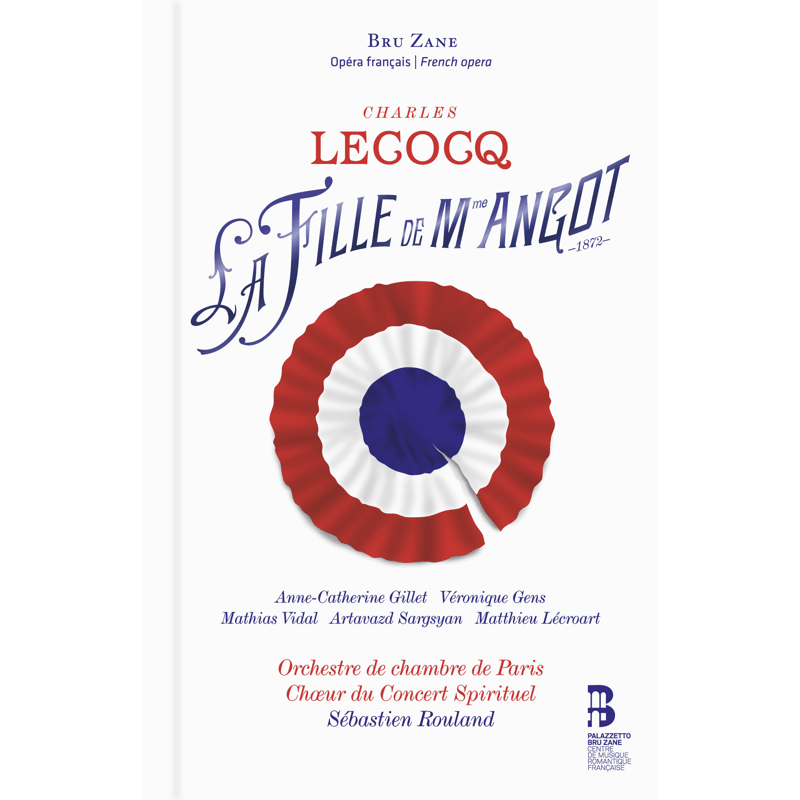- The Opera Company of Philadelphia
- panpipe music
- Uganda
- Belle Miriam Silverman
- Prince Bob
- David Arditti
- William Barton
- Dorset
 PODCAST: John Dante Prevedini leads a discussion about Classical Music and Visual Disability, including contributions from Charlotte Hardwick, Robert McCarney, Halida Dinova and Giuseppe Pennisi.
PODCAST: John Dante Prevedini leads a discussion about Classical Music and Visual Disability, including contributions from Charlotte Hardwick, Robert McCarney, Halida Dinova and Giuseppe Pennisi.
 SPONSORED: CD Spotlight. A Very Joyous Disc - Brahms arranged by Kenneth Woods impresses Alice McVeigh.
SPONSORED: CD Spotlight. A Very Joyous Disc - Brahms arranged by Kenneth Woods impresses Alice McVeigh.
All sponsored features >>

After the End of the Reign of Terror
GIUSEPPE PENNISI listens to 'La fille de Madame Angot' by Charles Lecocq
'... not only a musicological revival but also nearly two hours of very enjoyable listening.'
The Palazzetto Bru-Zane Centre de Musique Romantique Française has produced another interesting discovery in an elegant 180 page book with two CDs in the covers: La fille de Madame Angot (Madame Angot's Daughter) by Charles Lecocq (1832-1918). He was a French composer, known for his opérettes and opéras comiques in the last few decades of the nineteenth century. He became the most prominent successor to Jacques Offenbach, and enjoyed considerable success in the 1870s and early 1880s, before the changing musical fashions made his style of composition less popular. His few serious works include the opera Plutus(1886), which was not a success, and the ballet Le cygne (1899). His only piece to survive in the regular modern operatic repertory is his 1872 opéra comique La fille de Madame Angot, even though revivals are few and far between.
Listen — Charles Lecocq: Ouverture (La fille de Madame Angot)
(CD1 track 1, 0:00-0:57) ℗ 2021 Palazzetto Bru Zane :
This CD set has a sterling vocal cast - Anne-Cathérine Gillet, Véronique Gens, Mathias Vidal, Artavazd Sargsyan, Matthieu Lécroart, Antoine Philippot, Ingrid Perruche, Flannan Obé and David Witczak; in the pit, the Orchestre de Chambre de Paris conducted by Sébastien Rouland. The chorus is the Coeur de Concert Spirituel.
La fille de Madame Angot is an opéra comique in three acts to a libretto by Chales Clairville, Paul Siraudin and Victor Koning. The opera was first presented at the Fantaisies-Parisiennes in Brussels on 4 December 1872, and ran for more than five hundred performances. In Paris, where it opened on 21 February 1873 at the Théâtre des Folies-Dramatiques, it enjoyed a run of 411 performances and set box-office records for the receipts. Productions quickly followed in theatres throughout France: within a year of the opening of the Paris production, the work had been staged in 103 French cities and towns. Soon it became a success in Paris, London, New York and across continental Europe. It was one of the most successful works of French-language musical theatre in the last three decades of the ninetenth century, and out-performed other noted international hits such as H M S Pinafore and Die Fledermaus.
The plot develops in the Directoire in 1794, just after the bloody end of the French Revolution and the Reign of Terror. It deals with the romantic exploits of Clairette, a young Parisian florist, engaged to one man but in love with another, and up against a richer and more powerful rival for the latter's attentions. Unlike some more daring French comic operas of the times, the plot of La fille de Madame Angot proved exportable to more strait-laced countries without the need for extensive rewriting, and Lecocq's score was received with enthusiasm wherever it was played.
Lecocq's librettists set the piece in a unfamiliar setting for a comic opera. Their characters, though essentially fictional, incorporate elements of real people from the Revolutionary period. Mademoiselle Lange was a prominent actress and anti-government activist, but there is no evidence that the historical figure was Barras's mistress as she is in the opera. There was a real activist called Ange Pitou (fictionalised in a novel by Dumas), but he had no known connection with Mlle Lange. The black collars, used as a badge by the conspirators in the opera, are a reference to a song by the historical Pitou, 'Les collets noirs'. The heroine's mother, Madame Angot - the formidable market woman with aspirations - is fictional, but was not the invention of the librettists, being a stock character in stage comedy of the Revolutionary period. The plot is quite complicated and provides the opportunity for several funny situations.
The comic opera starts with a merry overture and chorus that provide the context of the return to normal happy Parisian life after the Reign of Terror.
Listen — Charles Lecocq: Bras dessus, bras dessous tous ensemble
(La fille de Madame Angot, Act I)
(CD1 track 2, 0:00-0:36) ℗ 2021 Palazzetto Bru Zane :
Then, the main characters are presented; particularly interesting are the romance and ensemble where Clairette (Anne-Cathérine Gillet) and Pomponnet (Artavazd Sargsyan) are introduced, and the duet between Clairette and Pitou (Mathias Vidal).
Listen — Charles Lecocq: Je vous dois tout, moi l'enfant de la Halle
(La fille de Madame Angot, Act I)
(CD1 track 4, 0:00-0:42) ℗ 2021 Palazzetto Bru Zane :
The first act ends with a joyful final and a chanson politique where the full cast is involved.
Listen — Charles Lecocq: Jadis les rois, race proscrite (La fille de Madame Angot, Act I)
(CD1 track 16, 0:00-0:59) ℗ 2021 Palazzetto Bru Zane :
In the second act, we are introduced to Mademoiselle Lange (Véronique Gens) in a brilliant couplet with chorus.
Listen — Charles Lecocq: WORK (La fille de Madame Angot, Act II)
(CD1 track 20, 0:44-1:31) ℗ 2021 Palazzetto Bru Zane :
Worth noting are the romance and the quintets.
Listen — Charles Lecocq: Quintet: Hein! (La fille de Madame Angot, Act II)
(CD2 track 1, 1:35-2:28) ℗ 2021 Palazzetto Bru Zane :
In the third act, the plot evolves with a series of ensembles. The finale, made up of two musical numbers - a trio with chorus and a concertato where all the members of the cast and the chorus are on stage - is very enthralling.
Listen — Charles Lecocq: Duo des lettres (La fille de Madame Angot, Act III)
(CD2 track 16, 2:24-3:21) ℗ 2021 Palazzetto Bru Zane :
In short, this is not only a musicological revival but also nearly two hours of very enjoyable listening.
Copyright © 24 October 2021
Giuseppe Pennisi,
Rome, Italy

CD INFORMATION: LA FILLE DE MADAME ANGOT
MORE CLASSICAL MUSIC ARTICLES ABOUT FRANCE


